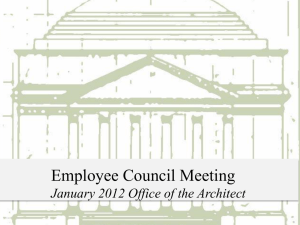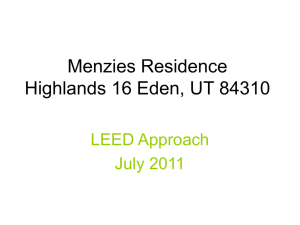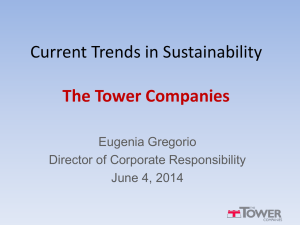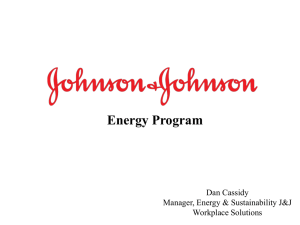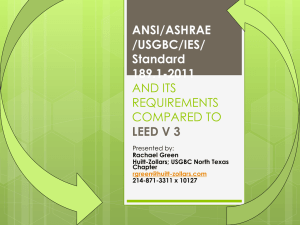Richland County Council Request of Action
advertisement
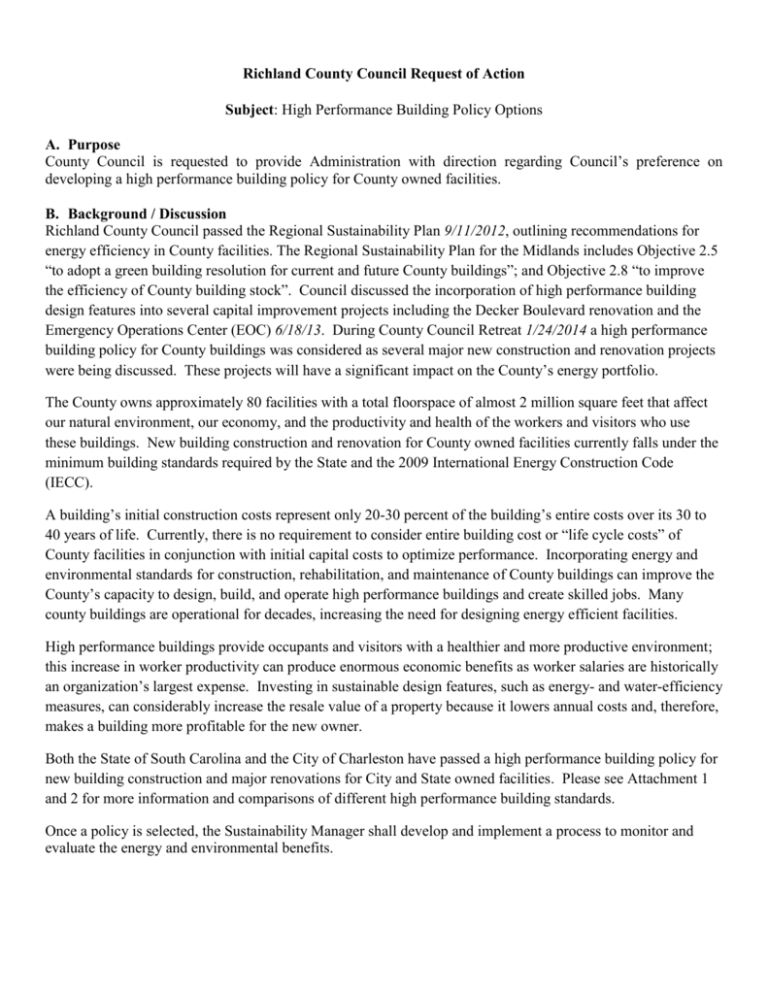
Richland County Council Request of Action Subject: High Performance Building Policy Options A. Purpose County Council is requested to provide Administration with direction regarding Council’s preference on developing a high performance building policy for County owned facilities. B. Background / Discussion Richland County Council passed the Regional Sustainability Plan 9/11/2012, outlining recommendations for energy efficiency in County facilities. The Regional Sustainability Plan for the Midlands includes Objective 2.5 “to adopt a green building resolution for current and future County buildings”; and Objective 2.8 “to improve the efficiency of County building stock”. Council discussed the incorporation of high performance building design features into several capital improvement projects including the Decker Boulevard renovation and the Emergency Operations Center (EOC) 6/18/13. During County Council Retreat 1/24/2014 a high performance building policy for County buildings was considered as several major new construction and renovation projects were being discussed. These projects will have a significant impact on the County’s energy portfolio. The County owns approximately 80 facilities with a total floorspace of almost 2 million square feet that affect our natural environment, our economy, and the productivity and health of the workers and visitors who use these buildings. New building construction and renovation for County owned facilities currently falls under the minimum building standards required by the State and the 2009 International Energy Construction Code (IECC). A building’s initial construction costs represent only 20-30 percent of the building’s entire costs over its 30 to 40 years of life. Currently, there is no requirement to consider entire building cost or “life cycle costs” of County facilities in conjunction with initial capital costs to optimize performance. Incorporating energy and environmental standards for construction, rehabilitation, and maintenance of County buildings can improve the County’s capacity to design, build, and operate high performance buildings and create skilled jobs. Many county buildings are operational for decades, increasing the need for designing energy efficient facilities. High performance buildings provide occupants and visitors with a healthier and more productive environment; this increase in worker productivity can produce enormous economic benefits as worker salaries are historically an organization’s largest expense. Investing in sustainable design features, such as energy- and water-efficiency measures, can considerably increase the resale value of a property because it lowers annual costs and, therefore, makes a building more profitable for the new owner. Both the State of South Carolina and the City of Charleston have passed a high performance building policy for new building construction and major renovations for City and State owned facilities. Please see Attachment 1 and 2 for more information and comparisons of different high performance building standards. Once a policy is selected, the Sustainability Manager shall develop and implement a process to monitor and evaluate the energy and environmental benefits. The Sustainability Manager shall submit a report annually regarding major facility projects to County Council that includes: The buildings and building types designed to meet this standard; The certification level of each building designed, constructed, or renovated; Actual savings in energy costs; An outline of all environmental benefits, including, but not limited to, water resources savings and the reduction of waste generation; The ability of buildings to continue to operate at the standard to which it was originally certified; Any conflicts or barriers that hinder the effectiveness of program Definitions 1) "High-performance building" means a building designed to achieve integrated systems design and construction so as to significantly reduce or eliminate the negative impact of the built environment. 2) "Major facility project" means: (i) a County-funded new construction building project in which the building to be constructed is larger than five thousand gross square feet; (ii) a County-funded renovation project in which the project involves more than fifty percent of the replacement value of the facility or a change in use; or (iii) a County-funded commercial interior tenant fit-out project that is larger than seven thousand five hundred square feet of leasable area. (iv) a County-funded mixed use building in which the temperature controlled portion is larger than five thousand gross square feet; 3) "Major facility project" does not mean: (i) a building, regardless of size, that does not have conditioned space as defined by Standard 90.1 of the American Society of Heating, Refrigerating and Air-Conditioning Engineers; C. Legislative / Chronological History Richland County Council passed the Regional Sustainability Plan 9/11/2012, outlining recommendations for energy efficiency in County facilities. During County Council Retreat 1/24/2014, a high performance building policy for County buildings was discussed as several major new construction and renovation projects were being considered. D. Financial Impact The actual financial impact is not easily calculated due to the complexity of the variables. However, some estimates are laid out in Attachment 2. E. Alternatives Provide guidance to staff on the alternative(s) Council wishes to pursue: 1) Model the policy of the State of South Carolina to require that all major facility projects (as expressed in the definition section) for County owned facilities must meet the LEED Silver standard or better, with certification that causes the project to be designed and constructed in a manner that achieves the lowest thirty-year life cycle cost. 2) Require that all major facility projects (as expressed in the definition section) for County owned facilities must meet the two Green Globes standard, or better, with certification that causes the project to be designed and constructed in a manner that achieves the lowest thirty-year life cycle cost. 3) Require that all major facility projects for County owned facilities meet the ENERGY STAR Certification Rating, and strive to meet LEED or Green Globes certification to achieve the lowest thirty-year life cycle cost when funding allows. 4) Require that all major facility projects for County owned facilities meet the ASHRAE 189.1 Standard that causes the project to be designed and constructed in a manner that achieves the lowest thirty-year life cycle cost. 5) Take no action. F. Recommendation While alternates 1-4 all focus on better buildings, there are several differences that are notable to mention. If water and energy efficiency are council’s priority at the least cost, ENERGY STAR certification is provides a solid foundation. Alternatives 1 and 2 are very similar to each other and are often interchangeable in high performance building policies. Both 1 and 2 have certain point sections associated with energy and water efficiency but also focus on other factors that are not associated with energy including performance, building materials, etc. ASHRAE 189.1 is a strict standard that offers little flexibility and is designed as a code requirement. Alternative 3 is recommended as this option pursues energy and water efficient facilities at minimal cost while also allowing flexibility in design. ENERGY STAR creates healthy facilities with a focus on indoor air quality. While ENERGY STAR is not the leader in high performance buildings, it is a best first step to transitioning to efficient building infrastructure. Recommended by: Anna Lange Department: Administration Date: May 5th 2014 G. Reviews Finance Reviewed by: Daniel Driggers Recommend Council approval Comments regarding recommendation: Date: 5/15/14 Recommend Council denial Support Services Reviewed by: John Hixon Date: Recommend Council approval Recommend Council denial Comments regarding recommendation: Recommend approval of alternative #3 as well. This alternative has the greatest payback to the county in real energy savings and reduced greenhouse emissions for an added or remodeled facility. It is important to remember that any facility added to our inventory will impact the overall operational budget and greenhouse emissions. The purpose is to make that addition as efficient with as little negative impact as possible on the citizens and environment. Just for background information, we have been operating under the Administrators Directive for Air Quality Awareness and Improvement Policies since 9/16/10. As it relates to facilities this policy directs that we landscape new construction in a manner to reduce power equipment use, directs facility temperature settings for power and emissions reduction, and prohibits the use of appliances that are not county approved. On 12/22/10 Administration approved a policy that directs that departments requesting to add office equipment must provide justification as to how this will improve their ability to enhance the completion of their mission. This policy also states that all equipment replaced or added must be “Energy Star” or equivalently rated. We continue to ensure that when HVAC equipment, lighting, and plumbing fixtures are changed out due to attrition or remodel projects, they are replaced with the most efficient equivalent replacement available. In following this plan we have been successful in offsetting the electricity increases over the past 4 years that equate to about 24%. Legal Reviewed by: Elizabeth McLean Date: 5/16/14 Recommend Council approval Recommend Council denial Comments regarding recommendation: Policy decision left to Council’s discretion. Administration Reviewed by: Warren Harley Recommend Council approval Comments regarding recommendation: Date: Recommend Council denial Attachment 1: Examples of jurisdictions with internal High Performance Building Policies. Entity State Government City of Charleston Navy Army Department of Defense City of Asheville Durham County Town of Chapel Hill Location SC SC US Govt. US Govt. Standard LEED Silver/ 2 Green Globes LEED Certified LEED Gold 189.1 aspects Building Type New Construction/ Renovations New Construction/ Renovations New Construction/ Renovations New Construction/ Renovations US Govt. NC NC NC New Construction/ Renovations New Construction/ Renovations New Construction/ Renovations New Construction/ Renovations State Government City of Alanta City of Chamblee NC GA GA State Government GA LEED Siler LEED Gold/ Silver LEED Gold/ Silver LEED Silver ASHRAE 90.1-2004/Energy Star Appliances LEED Silver LEED Certified/ 1 Green Globe ASHRAE 90.1-2004/Energy Star Appliances Athens-Clark County City of Knoxville GA TN LEED Certified LEED Energy Star New Construction/ Renovations New Construction/ Renovations Energy Star All office equipment, appliances, lighting, and heating and cooling systems State Government TN Existing and New Construction New Construction/ Renovations New Construction/ Renovations New Construction/ Renovations Attachment 2: High Performance Building Standards Energy Star Energy Star is a government program administered by the U.S. Environmental Protection Agency (EPA) and the U.S. Department of Energy (DOE). For labeling commercial buildings, Energy Star evaluates conformance to energy and water efficiency. To earn the Energy Star Label, a building must achieve a score of at least 75 on a 0-100 point scale. A rating of 75 indicates that a particular building is performing more efficiently than 75% of buildings in its class. Richland County currently uses Energy Star Portfolio Manager to track energy efficiency projects from the Energy Efficiency and Community Block Grant. Cost Evaluation: According to the Environmental Protection Agency, Energy Star buildings use an average of 35% less energy and emit 35% fewer greenhouse gas emissions, more than offsetting nominal initial cost increases. Reductions are greater with building starting with a low energy performance score. When certified, the effective rent of Energy Star facilities is 6.5% higher and the transaction price for Energy Star buildings is 12.9% higher. (EPA). For every dollar spent on energy efficiency gross energy savings would yield two dollars in return (ACEEE). LEED LEED (Leadership in Energy and Environmental Design) is a product of the U.S. Green Building Council (USGBC). LEED’s Green Building Rating System is a points-based, national standard for developing high performance commercial buildings. Unlike Energy Star, which focuses on energy usage, LEED evaluates building performance in these green design categories: • sustainable sites • water efficiency • energy and atmosphere • materials and resources • indoor environmental quality • innovation and design process, and use of a LEED-accredited designer Depending on its performance in these categories, a building can be LEED certified in four levels of achievement: certified, silver, gold, and platinum. Like Energy Star, LEED has benefits for the building owner. These include recognition of quality buildings and environmental stewardship, and third-party validation of achievement. The LEED Silver rating has been used by State facilities in South Carolina since 2006. Energy Star products can be used in LEED buildings, and use Energy Star’s tools, such as Portfolio Manager, to measure a LEED-certified building’s energy performance. Please note that LEED compliance is no guarantee of an energy efficient building. Cost Evaluation: LEED buildings report a 20% life cycle cost reduction with as little as a 2-5% initial cost increase for LEED Silver and Gold certification. When certified the effective rent of LEED facilities is 5% higher and the transaction price for LEED buildings is 11% higher. (Fuerst) Green Globes Green Globes is an online green building rating and certification tool. The Green Building Initiative ("GBI") oversees Green Globes in the United States. GBI is an accredited standards developer under the American National Standards Institute (ANSI). Green Globes is similar to LEED in evaluating building performance, but is structured as a self-assessment to be done in-house using a project manager and design team. The system is questionnaire-based using an online tool so users can see how they are scoring. Cost Evaluation: Lifecycle benefits are comparable to LEED, however the transaction price for Green Globes buildings was noted at only 2-5% higher. Green Globes may have a reduced administrative cost due to the ease of access to the online tools. ASHRAE 189.1 (American Society of Heating, Refrigerating and Air Conditioning Engineers) Similar to LEED, Standard 189.1 covers site sustainability, water use efficiency, energy efficiency, indoor environmental quality and the building’s impact on the atmosphere, materials and resources and construction and plan for operation. The standard is not a design guide or a rating system, thus limiting flexibility. Green building rating systems have been developed for implementation as a voluntary system many optional credits allow focus on the green building aspects that are most important to the user. Unlike this, standard 189.1 is based on mandatory requirements that establish a baseline for high-performancebuildings. Cost Evaluation: Through performance or prescriptive paths, ASHRAE 189.1 energy performance standard is designed to provide at least a 30 percent energy improvement over ASHRAE Standard 90.1-2007.



